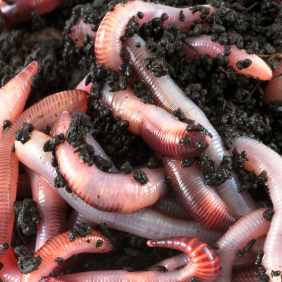Red wigglers: Feeding them properly
Boost Soil Health And Wellness Naturally With Red Wigglers
The integration of red wigglers into soil monitoring practices offers a compelling method for enhancing soil health naturally. These earthworms not only change natural waste into valuable vermicompost, yet their all-natural habits additionally promote improved dirt framework, aeration, and vitamins and mineral schedule. Nevertheless, comprehending the complexities of establishing up and keeping a successful vermicomposting system is essential to fully utilize their benefits. Checking out the important actions and possible difficulties entailed can significantly impact the efficiency of this lasting method. What key facets should be thought about to maximize the benefits of these remarkable decomposers?
Benefits of Red Wigglers

Additionally, red wigglers improve dirt framework by creating channels as they delve with the earth. This activity boosts aeration and drainage, promoting root growth and guaranteeing that plants obtain sufficient oxygen and dampness. Furthermore, the spreadings produced by red wigglers are high in nutrients such as nitrogen, phosphorus, and potassium, which are essential for plant advancement.
Red wigglers likewise aid in the reduction of hazardous pathogens and parasites by outcompeting them for sources, better adding to a much healthier dirt environment. Their visibility can bring about a decline in the need for synthetic plant foods and pesticides, promoting sustainable agricultural methods. In general, integrating red wigglers right into soil monitoring strategies offers an all-natural and efficient means of boosting dirt vitality, thereby sustaining robust plant growth and agricultural efficiency.
Establishing Up Vermicomposting
Developing a vermicomposting system is a sensible means to harness the amazing advantages of red wigglers in boosting dirt wellness. red wigglers. To start, pick an ideal container-- ideally, a plastic or wooden bin with a cover to preserve moisture and temperature. The container must have water drainage holes to avoid excess water build-up
Next, prepare bedding material, which functions as a habitat for the worms. Appropriate products include shredded newspaper, cardboard, or coconut coir. Purpose for a deepness of 4-6 inches to provide appropriate area for the worms.
Once the bedding remains in location, introduce the red wigglers, generally at a proportion of one pound of worms for every single square foot of surface location in the container. Following this, add kitchen area scraps such as vegetables and fruit peels, coffee premises, and smashed eggshells. Prevent meat, milk, and oily foods, as these can attract pests.
(red wiggler worms for sale near me)
Taking Care Of Your Worms
Preserving the well-being of your red wigglers is vital for a thriving vermicomposting system. Correct care ensures that these helpful organisms can efficiently break down natural issue and enhance your soil.
Feeding your worms is another essential aspect of their treatment. Red wigglers grow on kitchen area scraps such as fruit and veggie peels, coffee premises, and smashed eggshells.
Temperature administration is important; worms like a variety of 55 to 77 degrees Fahrenheit. Make certain the bin is not subjected to guide sunlight or extreme cold. Finally, frequently check for signs of distress, such as extreme worm movement or unusual odors, to resolve any possible issues immediately. By adhering to these standards, you will promote a healthy and balanced environment for your red wigglers.
Using Worm Castings in Dirt
Worm spreadings, often described as "black gold," are an effective amendment that can considerably enhance soil wellness and fertility. red wigglers. These nutrient-rich, natural plant foods are generated by red wigglers throughout their digestion procedure, causing a finely distinctive product that is useful for plants and soil alike
Integrating worm castings right into your dirt improves its structure, enhancing oygenation and water retention. This is specifically advantageous for sandy soils that drain pipes too promptly, in addition to hefty clay dirts that can become compacted. Worm spreadings are loaded with important nutrients, consisting of nitrogen, phosphorus, and potassium, which are essential for plant development.

Inevitably, using worm spreadings promotes a flourishing environment within the dirt, leading to healthier plants and even more sustainable horticulture methods.
Tips for Successful Composting
Successful composting needs cautious interest to a few crucial concepts that can considerably boost the quality of the end product. Balance is critical; maintain a correct proportion of eco-friendly products (nitrogen-rich) to brown materials (carbon-rich), preferably around 1:3. This equilibrium promotes effective decay and reduces smells.
2nd, oygenation plays an essential duty. Frequently transforming the compost heap enhances Hickory oxygen flow, which increases microbial task and speeds up the composting procedure. Purpose for a pile size of a minimum of three feet by three feet to maintain warm, which additionally advertises disintegration.
(Hickory)
Dampness content is one more vital element; the compost ought to perspire but not soggy. An excellent general rule is to attain a moisture level similar to that of a wrung-out sponge. Way too much water can result in anaerobic conditions, while as well little can slow down disintegration.
Lastly, check the temperature level of the garden compost. A temperature range of 130 ° F to 160 ° F indicates active composting and helps kill pathogens and weed seeds. By sticking to these concepts, you will produce a nutrient-rich compost that supports dirt wellness and improves plant development.
Verdict
Including red wigglers right into gardening techniques enhances soil health and wellness with all-natural procedures. These worms add to the malfunction of natural products, resulting in nutrient-rich vermicompost that boosts dirt structure and fertility. Their burrowing actions advertise aeration and drainage while reducing harmful virus and parasites. By developing and maintaining a vermicomposting system, garden enthusiasts can foster a sustainable ecosystem that sustains durable plant development and lasting dirt durability, eventually profiting farming performance and ecological wellness.